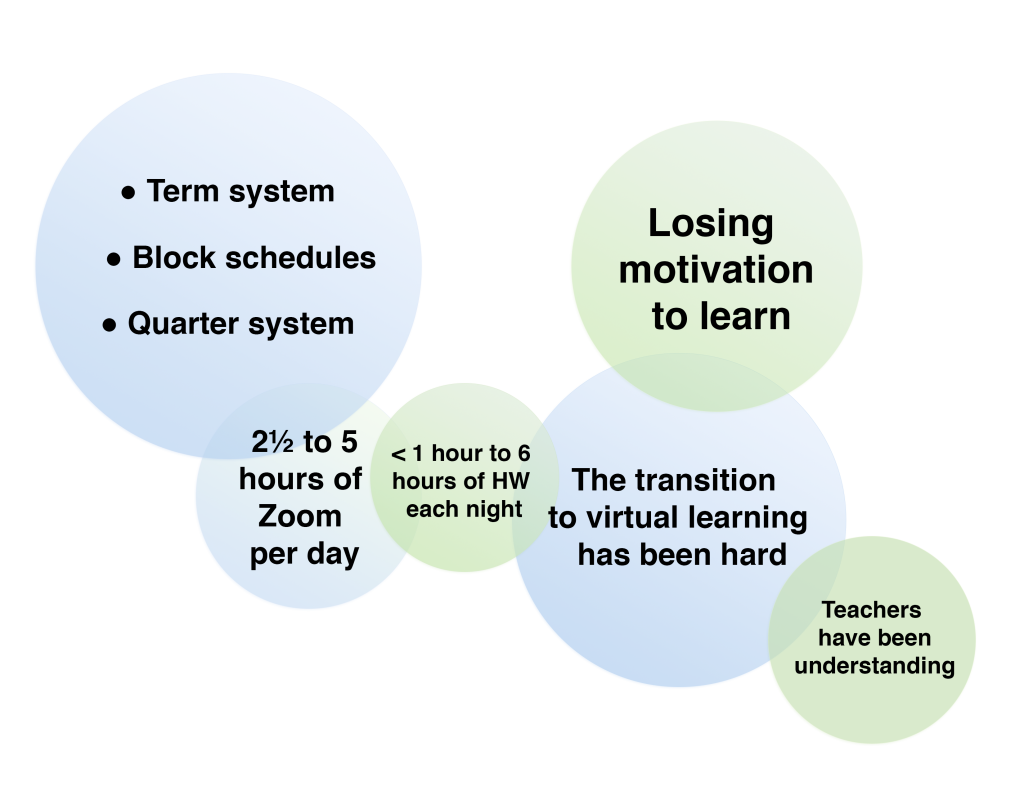All high schools in the Bay Area have recently been saddled with the same challenge: to continue providing education to thousands of students over virtual platforms. COVID-19 has hit public high schools especially hard because they tend to have larger student bodies and fewer available resources per student than private schools.
One adaptation Berkeley High School (BHS) has made for virtual school is the implementation of a term system, with students only taking half of their classes at a time. According to Oakland Technical High School (OTHS) junior Ivy Schoenberger, her school has implemented a similar system, wherein students take four classes in odd-numbered quarters, and a different four in even-numbered ones. Classes also switch off throughout the school week, so students only have two classes per day.
It seems that a variation of the term system and alternating classes has been adopted by several Bay Area public high schools. El Cerrito High School (ECHS) is also using a block schedule, reported Tabitha Reid, a sophomore there. “Most people do three classes one semester, four classes the next,” she said.
Albany High School (AHS) has also implemented a block schedule, explained sophomore Cynthia Kamau, with students taking the same four classes on Mondays and Wednesdays, and the other three on Tuesdays and Thursdays.
Many schools have shortened hours for online school, so students don’t have to spend six hours a day in Zoom calls. BHS has made school last only three hours per day. “For the most part, this semester I've spent three hours a day on Zoom,” said Reid about her experience at ECHS.
OTHS took this even further, shortening students’ typical daily Zoom time to a mere two and a half hours. Divergently, Kamau reported that AHS students must spend more time in their Zoom classes — either five hours and twenty minutes or four hours, depending on the day.
Another feature that varies widely across schools is the amount of homework students are assigned. “Last semester, I was taking pretty easy classes, and I had basically no homework every day,” said Reid. On the other hand, Schoenberger said her daily homework load is “two hours minimum and the maximum is … four or five hours.”

Kamau also reported large amounts of homework, saying, “I'm supposed to only get about an hour [of work] for each class [per day], but I seem to be getting about two to three assignments per class. … It takes me about … four to six hours a night.” She continued, “[Teachers] say things like, 'My class wouldn't be able to get through the school year if I didn't assign this much.’ ”
However, that’s not to say distance learning has been handled terribly by schools across the board. “Most teachers, and the school as a whole, have been super understanding of the fact that we are in unprecedented times,” said Reid. “Everyone's power in El Cerrito went out last week … so many kids I know couldn't come to class, and the teachers were just like, ‘Yeah, of course, you're fine.’”
Still, Reid said adjusting to virtual learning hasn’t been easy for her. Since it’s her first year at ECHS, she’s struggled more than the average student with the transition to distance learning. “With my being a transfer student, I don't know anyone. … It's really hard to make friends and that's one of the best parts of school,” she said. “Sometimes it gets really stressful … not being able to talk to your teachers face to face, because sometimes it's a lot to go to an office hour. Sometimes you just want to go up to someone after class and be like, ‘Hey, can I get a clarification on this?’ ”
Kamau also noted the stark differences between distance and in-person learning, saying, “I was really good at in-person learning … but since it changed to doing a bunch of other things like trying to look for outside sources of help … I definitely prefer in-school learning more than distance learning.”
Schoenberger concurred with Kamau’s preference. For her, distance learning is far from sustainable. She said, “[Distance learning] started out good. I had a lot of motivation and I was kind of enjoying it, but then, by the end of this first semester, I kind of lost all motivation. … It’s definitely harder to learn. I don't think I've learned anything this year.”





